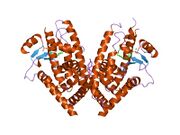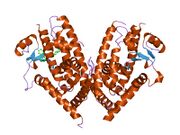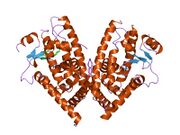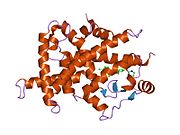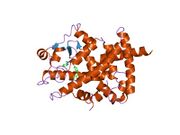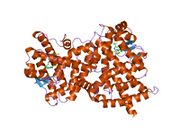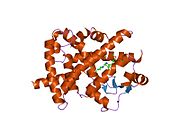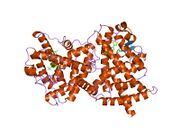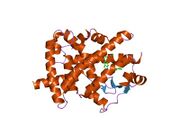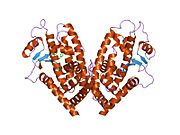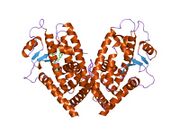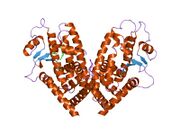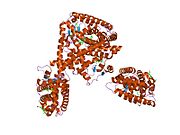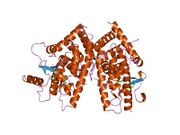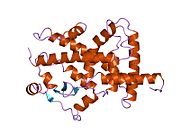Biology:Peroxisome proliferator-activated receptor gamma
 Generic protein structure example |
Peroxisome proliferator-activated receptor gamma (PPAR-γ or PPARG), also known as the glitazone reverse insulin resistance receptor, or NR1C3 (nuclear receptor subfamily 1, group C, member 3) is a type II nuclear receptor functioning as a transcription factor that in humans is encoded by the PPARG gene.[1][2][3]
Tissue distribution
PPARG is mainly present in adipose tissue, colon and macrophages. Two isoforms of PPARG are detected in the human and in the mouse: PPAR-γ1 (found in nearly all tissues except muscle) and PPAR-γ2 (mostly found in adipose tissue and the intestine).[4][5]
Gene expression
This gene encodes a member of the peroxisome proliferator-activated receptor (PPAR) subfamily of nuclear receptors. PPARs form heterodimers with retinoid X receptors (RXRs) and these heterodimers regulate transcription of various genes. Three subtypes of PPARs are known: PPAR-alpha, PPAR-delta, and PPAR-gamma. The protein encoded by this gene is PPAR-gamma and is a regulator of adipocyte differentiation. Alternatively spliced transcript variants that encode different isoforms have been described.[6]
The activity of PPARG can be regulated via phosphorylation through the MEK/ERK pathway. This modification decreases transcriptional activity of PPARG and leads to diabetic gene modifications, and results in insulin insensitivity. For example, the phosphorylation of serine 112 will inhibit PPARG function, and enhance adipogenic potential of fibroblasts.[7]
Function
PPARG regulates fatty acid storage and glucose metabolism. The genes activated by PPARG stimulate lipid uptake and adipogenesis by fat cells. PPARG knockout mice are devoid of adipose tissue, establishing PPARG as a master regulator of adipocyte differentiation.[8]
PPARG increases insulin sensitivity by enhancing storage of fatty acids in fat cells (reducing lipotoxicity), by enhancing adiponectin release from fat cells, by inducing FGF21,[8] and by enhancing nicotinic acid adenine dinucleotide phosphate production through upregulation of the CD38 enzyme.[9]
PPARG promotes anti-inflammatory M2 macrophage activation in mice.[10]
Adiponectin induces ABCA1-mediated reverse cholesterol transport by activation of PPAR-γ and LXRα/β.[11]
Many naturally occurring agents directly bind with and activate PPAR gamma. These agents include various polyunsaturated fatty acids like arachidonic acid and arachidonic acid metabolites such as certain members of the 5-hydroxyicosatetraenoic acid and 5-oxo-eicosatetraenoic acid family, e.g., 5-oxo-15(S)-HETE and 5-oxo-ETE or 15-hydroxyicosatetraenoic acid family including 15(S)-HETE, 15(R)-HETE, and 15(S)-HpETE,[12][13][14] the phytocannabinoid tetrahydrocannabinol (THC),[15] its metabolite THC-COOH, and its synthetic analog ajulemic acid (AJA).[16] The activation of PPAR gamma by these and other ligands may be responsible for inhibiting the growth of cultured human breast, gastric, lung, prostate and other cancer cell lines.[17][18]
During embryogenesis, PPARG first substantially expresses in interscapular brown fat pad.[19] The depletion of PPARG will result in embryonic lethality at E10.5, due to the vascular anomalies in placenta, with no permeation of fetal blood vessels and dilation and rupture of maternal blood sinuses.[20] The expression PPARG can be detected in placenta as early as E8.5 and through the remainder of gestation, mainly located in the primary trophoblast cell in the human placenta.[19] PPARG is required for epithelial differentiation of trophoblast tissue, which is critical for proper placenta vascularization. PPARG agonists inhibit extravillous cytotrophoblast invasion. PPARG is also required for the accumulation of lipid droplets by the placenta.[7]
Interactions
Peroxisome proliferator-activated receptor gamma has been shown to interact with:
- Tetrahydrocannabivarin
- Cannabidiol
- Anandamide
- CD36[10]
- EDF1[21][22][23]
- EP300[24][25]
- HDAC3[24][26]
- MED1[25]
- NCOA3[25]
- NCOA4[27]
- NCOA2[25]
- NR0B2[28]
- PPARGC1A[29][30]
- RB1.[24]
- miR3666[31]
Research
PPAR-gamma agonists have been used in the treatment of hyperlipidaemia and hyperglycemia.[32][33]
Many insulin sensitizing drugs (namely, the thiazolidinediones) used in the treatment of diabetes activate PPARG as a means to lower serum glucose without increasing pancreatic insulin secretion. Activation of PPARG is more effective for skeletal muscle insulin resistance than for insulin resistance of the liver.[34]
See also
- Endocannabinoid system
- Endocannainoidome
References
- ↑ "Isolation of the human peroxisome proliferator activated receptor gamma cDNA: expression in hematopoietic cells and chromosomal mapping". Gene Expression 4 (4–5): 281–99. 1995. PMID 7787419.
- ↑ "Molecular cloning, expression and characterization of human peroxisome proliferator activated receptors gamma 1 and gamma 2". Biochemical and Biophysical Research Communications 224 (2): 431–7. July 1996. doi:10.1006/bbrc.1996.1044. PMID 8702406.
- ↑ "International Union of Pharmacology. LXI. Peroxisome proliferator-activated receptors". Pharmacological Reviews 58 (4): 726–41. December 2006. doi:10.1124/pr.58.4.5. PMID 17132851.
- ↑ "The organization, promoter analysis, and expression of the human PPARgamma gene". The Journal of Biological Chemistry 272 (30): 18779–89. July 1997. doi:10.1074/jbc.272.30.18779. PMID 9228052.
- ↑ "Distinct Roles of Transcription Factors KLF4, Krox20, and Peroxisome Proliferator-Activated Receptor γ in Adipogenesis". Molecular and Cellular Biology 37 (2): 18779–89. January 2017. doi:10.1128/MCB.00554-16. PMID 27777310.
- ↑ "Entrez Gene: PPARG peroxisome proliferator-activated receptor gamma". https://www.ncbi.nlm.nih.gov/sites/entrez?Db=gene&Cmd=ShowDetailView&TermToSearch=5468.
- ↑ 7.0 7.1 "Expression and potential role of peroxisome proliferator-activated receptor gamma in the placenta of diabetic pregnancy". Placenta 28 (4): 315–23. April 2007. doi:10.1016/j.placenta.2006.04.002. PMID 16753211. http://ousar.lib.okayama-u.ac.jp/10879.
- ↑ 8.0 8.1 "PPARγ signaling and metabolism: the good, the bad and the future". Nature Medicine 19 (5): 557–66. May 2013. doi:10.1038/nm.3159. PMID 23652116.
- ↑ "NAADP mediates insulin-stimulated glucose uptake and insulin sensitization by PPARγ in adipocytes". Cell Reports 2 (6): 1607–19. December 2012. doi:10.1016/j.celrep.2012.10.018. PMID 23177620.
- ↑ 10.0 10.1 "Oxidative stress in atherosclerosis development: the central role of LDL and oxidative burst". Endocrine, Metabolic & Immune Disorders Drug Targets 12 (4): 351–60. December 2012. doi:10.2174/187153012803832602. PMID 23061409.
- ↑ "The role of adiponectin in cholesterol efflux and HDL biogenesis and metabolism". Metabolism 100: 153953. November 2019. doi:10.1016/j.metabol.2019.153953. PMID 31377319.
- ↑ "Positive regulation of the peroxisomal beta-oxidation pathway by fatty acids through activation of peroxisome proliferator-activated receptors (PPAR)". Biology of the Cell 77 (1): 67–76. 1993. doi:10.1016/s0248-4900(05)80176-5. PMID 8390886.
- ↑ "5-Oxo-ETE analogs and the proliferation of cancer cells". Biochimica et Biophysica Acta (BBA) - Molecular and Cell Biology of Lipids 1736 (3): 228–36. October 2005. doi:10.1016/j.bbalip.2005.08.009. PMID 16154383.
- ↑ "15-hydroxyeicosatetraenoic acid is a preferential peroxisome proliferator-activated receptor beta/delta agonist". Molecular Pharmacology 77 (2): 171–84. February 2010. doi:10.1124/mol.109.060541. PMID 19903832.
- ↑ "Novel time-dependent vascular actions of Delta9-tetrahydrocannabinol mediated by peroxisome proliferator-activated receptor gamma". Biochemical and Biophysical Research Communications 337 (3): 824–31. November 2005. doi:10.1016/j.bbrc.2005.09.121. PMID 16213464.
- ↑ "Activation and binding of peroxisome proliferator-activated receptor gamma by synthetic cannabinoid ajulemic acid". Molecular Pharmacology 63 (5): 983–92. May 2003. doi:10.1124/mol.63.5.983. PMID 12695526.
- ↑ "Biology of PPAR gamma in cancer: a critical review on existing lacunae". Current Molecular Medicine 7 (6): 532–40. September 2007. doi:10.2174/156652407781695765. PMID 17896990.
- ↑ "Downregulation of fatty acid oxidation by involvement of HIF-1α and PPARγ in human gastric adenocarcinoma and its related clinical significance". Journal of Physiology and Biochemistry 77 (2): 249–260. May 2021. doi:10.1007/s13105-021-00791-3. PMID 33730333. https://pubmed.ncbi.nlm.nih.gov/33730333/.
- ↑ 19.0 19.1 "PPAR gamma is required for placental, cardiac, and adipose tissue development". Molecular Cell 4 (4): 585–95. October 1999. doi:10.1016/s1097-2765(00)80209-9. PMID 10549290.
- ↑ "The pleiotropic function of PPAR gamma in the placenta". Molecular and Cellular Endocrinology 249 (1–2): 10–5. April 2006. doi:10.1016/j.mce.2006.02.009. PMID 16574314.
- ↑ "Multiprotein bridging factor-1 (MBF-1) is a cofactor for nuclear receptors that regulate lipid metabolism". Molecular Endocrinology 16 (6): 1367–77. June 2002. doi:10.1210/mend.16.6.0843. PMID 12040021.
- ↑ "A PPARgamma mutant serves as a dominant negative inhibitor of PPAR signaling and is localized in the nucleus". Molecular and Cellular Endocrinology 162 (1–2): 57–67. April 2000. doi:10.1016/S0303-7207(00)00211-2. PMID 10854698.
- ↑ "Asymmetry in the PPARgamma/RXRalpha crystal structure reveals the molecular basis of heterodimerization among nuclear receptors". Molecular Cell 5 (3): 545–55. March 2000. doi:10.1016/S1097-2765(00)80448-7. PMID 10882139.
- ↑ 24.0 24.1 24.2 "The retinoblastoma-histone deacetylase 3 complex inhibits PPARgamma and adipocyte differentiation". Developmental Cell 3 (6): 903–10. December 2002. doi:10.1016/S1534-5807(02)00360-X. PMID 12479814.
- ↑ 25.0 25.1 25.2 25.3 "Ligand type-specific interactions of peroxisome proliferator-activated receptor gamma with transcriptional coactivators". The Journal of Biological Chemistry 275 (43): 33201–4. October 2000. doi:10.1074/jbc.C000517200. PMID 10944516.
- ↑ "Interaction of nuclear receptor zinc finger DNA binding domains with histone deacetylase". Molecular and Cellular Endocrinology 206 (1–2): 1–12. August 2003. doi:10.1016/S0303-7207(03)00254-5. PMID 12943985.
- ↑ "Identification of ARA70 as a ligand-enhanced coactivator for the peroxisome proliferator-activated receptor gamma". The Journal of Biological Chemistry 274 (23): 16147–52. June 1999. doi:10.1074/jbc.274.23.16147. PMID 10347167.
- ↑ "Small heterodimer partner, an orphan nuclear receptor, augments peroxisome proliferator-activated receptor gamma transactivation". The Journal of Biological Chemistry 277 (2): 1586–92. January 2002. doi:10.1074/jbc.M104301200. PMID 11696534.
- ↑ "Coordination of p300-mediated chromatin remodeling and TRAP/mediator function through coactivator PGC-1alpha". Molecular Cell 12 (5): 1137–49. November 2003. doi:10.1016/S1097-2765(03)00391-5. PMID 14636573.
- ↑ "Activation of PPARgamma coactivator-1 through transcription factor docking". Science 286 (5443): 1368–71. November 1999. doi:10.1126/science.286.5443.1368. PMID 10558993.
- ↑ "miR-3666 inhibits development of hepatic steatosis by negatively regulating PPARγ". Biochimica et Biophysica Acta (BBA) - Molecular and Cell Biology of Lipids 1865 (10): 158777. October 2020. doi:10.1016/j.bbalip.2020.158777. PMID 32755726.
- ↑ "The many faces of PPARgamma". Cell 123 (6): 993–9. December 2005. doi:10.1016/j.cell.2005.11.026. PMID 16360030.
- ↑ "The multifaceted factor peroxisome proliferator-activated receptor γ (PPARγ) in metabolism, immunity, and cancer". Archives of Pharmacal Research 38 (3): 302–12. March 2015. doi:10.1007/s12272-015-0559-x. PMID 25579849.
- ↑ "Contributions of beta-cell dysfunction and insulin resistance to the pathogenesis of impaired glucose tolerance and impaired fasting glucose". Diabetes Care 29 (5): 1130–9. May 2006. doi:10.2337/dc05-2179. PMID 16644654.
This article incorporates text from the United States National Library of Medicine, which is in the public domain.
 |


